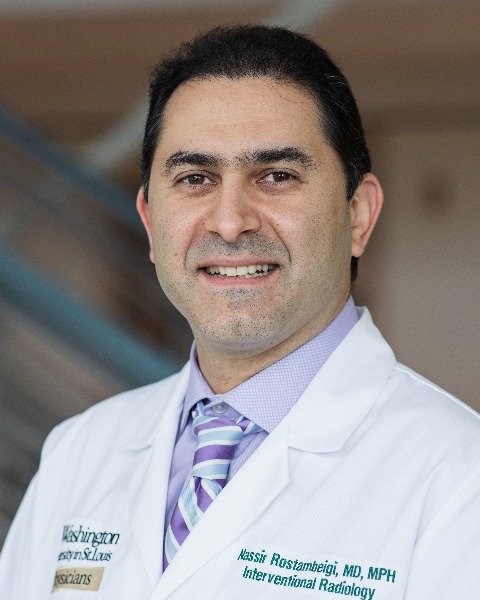Abstracts
Safety and efficacy of adjunctive coil embolization after prostatic artery embolization
Friday, May 19, 2023
1:18 PM - 1:36 PM East Coast USA Time
Location: New York East

Nassir Rostambeigi, MD, MPH
Washington University in St. Louis
Washington University in St. Louis
Chesterfield, Missouri, United States
Primary Author(s)
Background: Prostate artery recanalization after prostatic artery embolization (PAE) is suggested as one of the major etiologies for recurrence of symptoms after PAE. Coil embolization of main prostatic artery after particle embolization is theorized to reduce recanalization and prostate regrowth.
Purpose/Objective: To study safety and efficacy of coil embolization of main prostatic artery after particle prostatic artery embolization (Coil-Out technique).
Materials & Methods: A retrospective single center analysis of 103 patients from July 2020-Dec 2022, who underwent successful bilateral PAEs was conducted. Coil-out technique was started at ~1 yr after initiation of this practice. Technical factors, clinical outcomes, adverse events and repeat embolization were collected and compared between coil-out technique and standard PAE.
Results: Mean (SD) patient age and prostate volume were 72 (9) years and 132 (109) milliliters. Four (3.8%) and 25 (24%) patients required PAE for treatment of gross hematuria and retention, respectively. 69 patients (67%) underwent Coil Out technique. At 1 month, international prostate symptoms scores (IPSS) decreased from 20 to 6 and quality of life improved from 5 to 1 (p < 0.001). Success for resolution of hematuria was %100, and for resolution of retention was 96%. Overall 83 patients (91%) had clinical response, with no difference between coil-out and standard techniques (p=0.7). One patient from each group admitted for 2 days after PAE for pain control. Post embolization syndrome was experienced between 3-10 days after procedure without difference between groups. Follow up erectile function was no different. Hematuria or hematospermia were similar (p=0.1). During median follow-up of 6 months (range 1-33 months), no repeat PAE was performed.
Conclusion: Coil Out technique has similar safety profile to the standard PAE technique. Short term clinical response is similar to standard technique. Future studies are needed to evaluate the long term efficacy of this technique in reducing the recurrence after PAE.
Purpose/Objective: To study safety and efficacy of coil embolization of main prostatic artery after particle prostatic artery embolization (Coil-Out technique).
Materials & Methods: A retrospective single center analysis of 103 patients from July 2020-Dec 2022, who underwent successful bilateral PAEs was conducted. Coil-out technique was started at ~1 yr after initiation of this practice. Technical factors, clinical outcomes, adverse events and repeat embolization were collected and compared between coil-out technique and standard PAE.
Results: Mean (SD) patient age and prostate volume were 72 (9) years and 132 (109) milliliters. Four (3.8%) and 25 (24%) patients required PAE for treatment of gross hematuria and retention, respectively. 69 patients (67%) underwent Coil Out technique. At 1 month, international prostate symptoms scores (IPSS) decreased from 20 to 6 and quality of life improved from 5 to 1 (p < 0.001). Success for resolution of hematuria was %100, and for resolution of retention was 96%. Overall 83 patients (91%) had clinical response, with no difference between coil-out and standard techniques (p=0.7). One patient from each group admitted for 2 days after PAE for pain control. Post embolization syndrome was experienced between 3-10 days after procedure without difference between groups. Follow up erectile function was no different. Hematuria or hematospermia were similar (p=0.1). During median follow-up of 6 months (range 1-33 months), no repeat PAE was performed.
Conclusion: Coil Out technique has similar safety profile to the standard PAE technique. Short term clinical response is similar to standard technique. Future studies are needed to evaluate the long term efficacy of this technique in reducing the recurrence after PAE.
